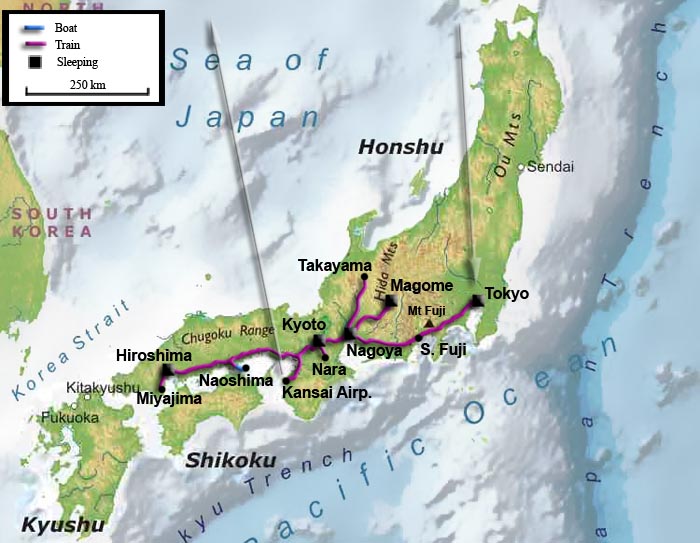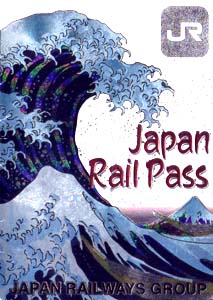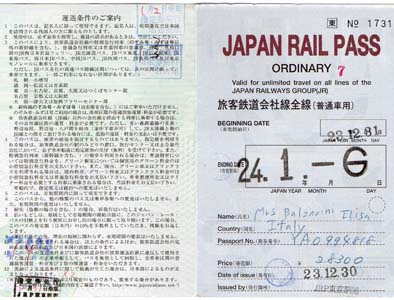HOME > Japan
 |
Japan
13 days ,
Dec'11
|
TRAVEL IN JAPAN
| Day | Transport | Night | Price | Duration | |
| 1 | Milan- Rome- Tokyo | Flight |
420€ (back and forth) | 1h + 11.5h | |
| 1,2,3 | Tokyo | On foot + metro | |||
| 1,2,3 night | Tokyo | Kaosan Samurai Hostel | 30€ pp for a twin | ||
| 4 | Tokyo- Shin Fuji | Shinkansen Train | JR pass (73€) | 70min | |
| 4 | Shin Fuji- Nagoya- Nakatsugawa | Train | JR pass (90€) | 1.5h + 80min | |
| 4 | Nakatsugawa- Magome | Bus | 6€ | 30min | |
| 4 night | Magome | Chaya Magome Minshukhu | 80€ pp (japanese room with futon) (breakfast & dinner included) | ||
| 5 | Magome-
Tsumago- Nagiso |
on foot | 3.5h (11km) | ||
| 5 | Nagiso- Nagoya | Train | JR pass (20€) | 1.5h | |
| 5 night | Nagoya
|
B-Nagoya hotel | 60€ per double room | ||
| 6 | Nagoya-
Takayama |
Train | JR pass (60€) | 2h 20min | |
| 6 | Takayama-
Nagoya- Kyoto |
Train | JR pass (100€) | 2.3h + 40min | |
| 6,7 night | Kyoto | K'house hostel | 28€ pp for a twin | ||
| 7 | Kyoto-
Nara- Kyoto |
Train | JR pass | 40min | |
| 8 | Kyoto- Okayama-Chayamachi- Uno | Train | JR pass (87€) | 1.5h+15min +15min | |
| 8 | Uno-
Miyanoura (Naoshima) |
Boat | 10€ (back and forth) | 20min | |
| 8 | Naoshima roundtour | Bike | bike rental: 7€ pp for full day | 4h | |
| 8 | Miyanoura (Naoshima)- Uno | Boat | 10€ (back and forth) | 20min | |
| 8 | Uno- Chayamachi- Okayama- Hiroshima | Train | JR pass (68€) | 15min+15min + 50min | |
| 8,9 night | Hiroshima | J Hoppers Hostel | 30€ pp (japanese room with futon) | ||
| 9 | Hiroshima- Miyajima- Iwakuni Hiroshima | Train | JR pass | 25min +25min + 50min | |
| 10 | Hiroshima- Kyoto | Train | JR pass (110€) | 2.5h | |
| 10 night | Kyoto | 9 hours capsule hotel | 49€ pp | ||
| 11 | Kyoto | On foot + metro | 28€ pp for a twin | ||
| 11 nigth | Kyoto | K'house hostel | 30€ pp | 1.5h | |
| 12 | Kyoto- Osaka Kansai airport | Train | 420€ (back and forth) | 13h + 1h | |
| 12 | Osaka K. airport- Rome- Milan | Flight |
Landed in Tokyo after a 12h haul from Rome we settled in the
Khaosan Samurai Guesthouse in the convenient area of Akusaka
(read: 'Asaksa'). We spent 3 days in Tokyo moving on foot and
by the extensive (and expensive: one ticket: 2- 2.7€!)
metro, getting the first shock with the Japanese Manga obsession.
Considering the first day we were jet lagged (hence counts as
half), they have been enough to have a look at the capital without
miss too much or getting bored. We decided not to visit Nikko
or Kamakura since we would have had enough of temples later
on.
The last day at the Tokyo Station we changed our 'Exchange Order',
we got in Italy by the HIS agency, in the JR pass (read
for details).
Our first destination leaving the capital has been Shin Fuji;
the place itself has nothing worth, besides the view of the
Fuji mountain from the station platform. However unfortunately
we didn't enjoy any panorama since the Fuji was capped by the
clouds as it often happens .Proceeding by train at first to
Nagoya, then to Nakatsugawa and finally by bus we found ourselves
in the hearth of the Japanese Alps in the authentic village
of Magome. We stayed in a typical wooden Japanese guesthouse
(a ryokan called Chaya Magome) where in line with the Japanese
style we slept on the futon(thin mattress) laid on the tatami
(mats). It was the New Years Eve and after having had an abundant
dinner at the guesthouse restaurant, at midnight we celebrated
the New Year hitting the bell (108 hits according to the tradition)
in the temple and drinking sake; it has one of the best memory
of the whole trip!
The following morning with walked to Tsumago and then to the
train station of Nagiso covering 11km in 3.5h. It has been a
nice easy walk, with few cm's of snow and on the way we even
met a samurai, he had the sword! I guess a guy who dressed up
to celebrate the New Year. I recommend the walk for those who
want to have an insight of the Japanese Alps but I found Magome
more charming than Tsumago, even if the latter is still a typical
village. To enjoy even more the walk my advice is to use the
locker at the Nakatsugawa station at the arrival leaving there
most of your stuffs and retrieve them on the way back (train
from Nagiso stops at Nakatusgawa) or in summer there's a service
of luggage delivery from Magome to Tsumago.
In Nagiso we took the train reaching Kyoto in few hours: the
former capital of Japan is the highlight of the whole country
and with the nearby town of Nara (don't miss it!), you'll have
so many temples to visit that for sure you'll have enough. Anyway
Kyoto is not just temples, but it's the typical town recalling
in most of his areas what is the international imagine of Japan.
For instance having the chance to see some Geisha sneaking along
the cobblestone narrow streets of the Gijon quarter. We stayed
at the K'house hostel, it's the most convenient place to stay
if you are travelling with a tight budget.
The following day by train we reached the harbor of Uno from
where we took a 20min ferry to the Island of Naoshima; the place
is renowned for its collection of contemporary art galleries
and exhibits: there are 2 museums (Bennesse House, Chichu Museum)
and a number of houses in this town have been radically reformed
in the Art House Project.You can visit the all places renting
a bike in 4hours; although tickets are expensive (40€)
and some works are far from being artistic, I recommend it even
if for non fan of contemporary art, but the all stuffs in such
location are quite unique. If you want to enjoy it but limiting
the expense visit just the Chichu Museum (20€). Hiroshima
is 1.5h from Uno by train (with few changes though), and needless
to say the highlight here is the A-Bomb park and the impressive
memorial museum.We stayed at the J Hopper hostel (30€ pp
per double room) sleeping in a Japanese room, namely laying
on the floor with the futon (thin mattress) over the tatami
(mats). We visited Miyajima island (25km from Hiroshima) where
is located the most photographed spot of Japan: the Torii (wooden
red arch) in the water. Such Torii built on the sea shore and
when there's the high tide it seems floating on the water. The
same day we saw the Iwakuni bridge. Consider one day enough
visiting Hiroshima, Miyajima and Iwakuni, theoretically you
can do it even in a one day trip from Kyoto but it's going to
be a looong day.
Back to Kyoto we enjoyed the last two days wandering around
the town and visiting the several temples, also because our
JR pass expired and moving would have been not affordable! We
slept in a capsule hotel, or better in the coolest of the capsule
hotel you can find in Japan: http://9hours.jp/systems/index
Our budget got the final strike with the train from Kyoto to
the Osaka Kansai Airport: 1h travel for 30€!
Alby
Japan travel tip
|
||||||||||||||||||||||||||||
|
||||||||||||||||||||||||||||
|
EU citizens staying less than 90 days don't require anything more than their passport to get a medium size sticker on it together with a piece of the immigration form stapled (and then removed)
The currency is the Yen, at the time of writing
he was amazilngly strong vs euro(1€= 97Yen, Dec2011),
however few years ago it happen to have 1€= 150Yen, I
hope you'll be luckier them me!!
I had Japan Lonley Planet (in italian 11th version), generally a good support, but I wonder why there's am estensive coloured chapter on 'Japanese architecure' instead of more practical. For instance pictures of the food? It's impossibile to understand what is a zaru soba untill you don't see a picture. What about a map of the Nagoya metro line or Hiroshima tram network?
In Japan you can lick the floor on the streets:-) maybe avoid to do it 50km from Fukushima Nuclear Power station!
|

